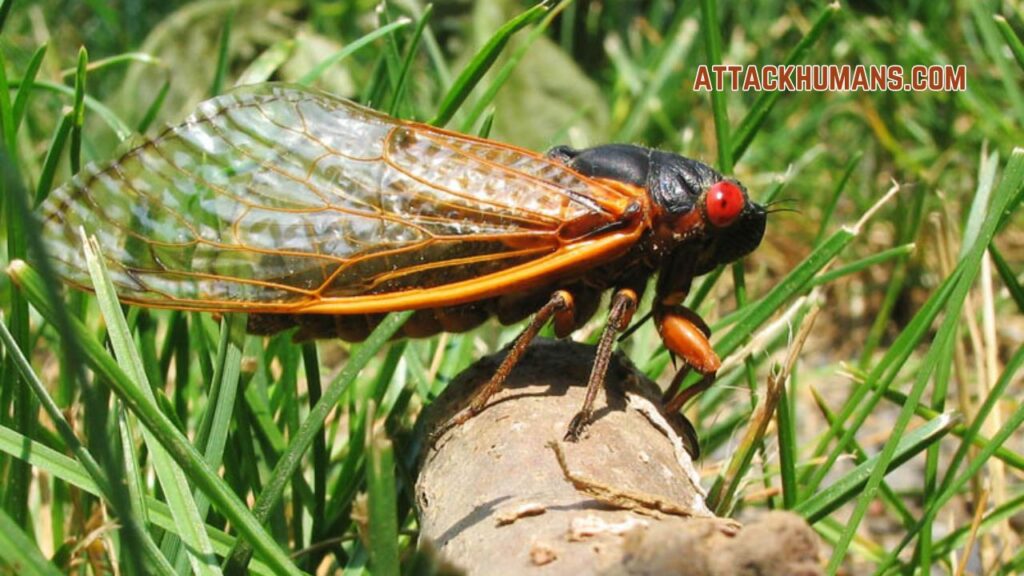Do Cicadas Attack Humans? Cicadas do not attack humans; they are harmless insects that primarily feed on tree sap.
Cicadas are unique insects known for their loud buzzing sounds and rare emergence patterns.
Depending on the species, cicadas can appear every year or remain underground for as long as 17 years before making an appearance.
When they do, it’s often in overwhelming numbers, causing curiosity and concern among those who encounter them.
Many people wonder if cicadas are dangerous or if they could potentially attack humans. While they can seem intimidating, cicadas are actually harmless creatures that play a vital role in their ecosystem.
In this article, we’ll delve into the world of cicadas, exploring what they are, why they emerge, and whether or not they pose any threat to people.
Contents
What Are Cicadas?
Overview of Cicadas:
Cicadas are insects belonging to the order Hemiptera and are closely related to aphids and leafhoppers. Their most distinctive features are their large eyes, transparent wings, and a loud call that can be heard from far away.
Cicadas have complex life cycles that often involve spending the majority of their lives underground. [Do Cicadas Attack Humans?]
Once they emerge, they undergo a short period of mating and egg-laying, making them a fascinating subject for entomologists and curious observers alike.
Types of Cicadas:
There are two primary types of cicadas: annual cicadas and periodical cicadas. Annual cicadas, as the name suggests, appear every year, typically in the summer.
They have a relatively short life cycle and are less synchronized than their periodical counterparts. [Do Cicadas Attack Humans?]
Periodical cicadas, on the other hand, emerge in massive swarms every 13 or 17 years, depending on the species.
These periodical cicadas are known for their large-scale appearances and synchronized timing, which makes them a rare and remarkable phenomenon in nature.
The Life Cycle of Cicadas:
After a female cicada lays eggs, they hatch into tiny nymphs that burrow into the ground. There, they feed on tree roots and develop over the course of several years.
When they’re fully mature, they emerge from the ground, shed their exoskeletons, and take on their adult form. After mating, adult cicadas die, and the cycle begins again.
This unique life cycle has evolved as a defense mechanism, allowing periodical cicadas to overwhelm predators through sheer numbers.

Do Cicadas Attack Humans?
Myth vs. Reality:
The idea that cicadas might attack humans is a common misconception, possibly fueled by their large size and loud noises. Cicadas are not aggressive, and they have no interest in attacking or harming people.
They lack the physical attributes needed to pose any danger to humans, such as stingers, venom, or strong jaws.
Cicadas are mainly concerned with finding mates and completing their reproductive cycle.
Feeding Habits:
Cicadas are sap-feeders. They use a proboscis, a needle-like mouthpart, to pierce tree branches and feed on sap.
This feeding mechanism is not designed to bite humans or animals. Cicadas do not feed on flesh or blood, and their diet is strictly limited to plant fluids.
Because of this, there’s no reason for them to attempt to bite or feed on humans. [Do Cicadas Attack Humans?]
Behavior Towards Humans:
Cicadas are naturally shy and avoid human contact as much as possible. When they fly toward people, it’s usually due to disorientation or clumsiness rather than an intent to attack.
Their primary focus during their short above-ground lifespan is to mate and lay eggs. [Do Cicadas Attack Humans?]
They’re not territorial or defensive, and they don’t display the aggressive behaviors found in some insects, like wasps or bees.
Physical Harmlessness:
Physically, cicadas are ill-equipped to harm humans. They lack stingers and venom glands, and their proboscis is only capable of puncturing soft plant tissue, not human skin.
While their large size can be intimidating, cicadas are completely harmless to humans. If one lands on you, it’s best to stay calm and gently brush it away. Cicadas will not bite, sting, or attack in response.
Potential for Nuisance:
The main “threat” cicadas pose is auditory. Male cicadas produce sounds as loud as 100 decibels, comparable to a lawnmower or a motorcycle.
This noise can be bothersome, especially in areas where cicadas are highly concentrated. [Do Cicadas Attack Humans?]
However, the noise is not a form of attack; it’s simply a mating call used to attract females. The loud sounds may be disruptive, but they don’t indicate any aggression or threat to humans.
Why Are People Afraid of Cicadas?
Loud Noise Factor:
One of the biggest reasons people fear cicadas is due to the loud, continuous noise they produce. For some, the sound is not only annoying but also anxiety-inducing.
The noise can feel especially overwhelming when hundreds or thousands of cicadas are present in one area.
Since the sound is unique to cicadas, people who are unfamiliar with them may interpret it as a warning or an aggressive signal.
Sudden Appearances:
Since cicadas spend most of their lives underground, they’re usually out of sight and out of mind. When they emerge, it can seem sudden and overwhelming, especially for those who live in areas where periodical cicadas appear.
The sheer numbers involved can make it feel like an “invasion,” which understandably causes alarm. [Do Cicadas Attack Humans?]
However, cicadas are merely following their natural life cycle, and their large-scale emergence is a defense mechanism rather than an aggressive display.
Misconceptions and Myths:
Many myths surround cicadas, including the belief that they can bite or sting. These misconceptions may be due to confusion with other insects, like locusts or wasps. Unlike these insects, cicadas are not interested in attacking humans.
They lack the physical capabilities to cause harm and are more likely to fly away than engage with humans directly.
Understanding these facts can help alleviate fear and dispel common myths about cicadas. [Do Cicadas Attack Humans?]

The Role of Cicadas in the Ecosystem
Pollination and Soil Health:
Cicadas contribute to the ecosystem in several ways. As they emerge from the ground, their tunnels aerate the soil, allowing air and nutrients to penetrate deeper layers.
After they die, their decomposing bodies provide a nutrient-rich fertilizer that benefits plants. [Do Cicadas Attack Humans?]
This contribution to soil health is particularly valuable for trees and other vegetation, which rely on nutrient-dense soil to thrive.
Source of Food for Other Animals:
Cicadas serve as a food source for a wide range of animals, including birds, mammals, reptiles, and other insects. [Do Cicadas Attack Humans?]
During periods of cicada emergence, these predators benefit from an abundant and easily accessible food supply.
Cicadas’ high numbers allow them to survive predation, and their periodic mass appearances help prevent predators from relying on them as a consistent food source. This balance contributes to the stability of local ecosystems.
Predator Satiation:
Cicadas use a survival strategy called “predator satiation.” By emerging in overwhelming numbers, they ensure that even though predators will eat many of them, enough cicadas will survive to reproduce and continue the cycle.
This strategy has allowed cicadas to thrive and maintain their unique life cycles over millions of years. [Do Cicadas Attack Humans?]
Are There Any Risks Associated with Cicadas?
Indirect Risks:
Although cicadas do not pose direct risks to humans, their presence can sometimes cause minor inconveniences.
For instance, the loud noise they produce can lead to headaches or stress, particularly for people sensitive to sound.
Additionally, in rare cases, individuals with respiratory issues may experience mild allergic reactions to cicada body parts or exoskeletons in the air.
Impact on Plants:
While cicadas don’t directly harm humans, they can affect young trees and plants. Female cicadas lay eggs by cutting small slits into tree branches.
These slits can weaken branches and cause them to break, especially in young or fragile trees.
For gardeners and those with young trees, covering saplings during cicada season can help protect them from damage.
Established, mature trees are usually resilient enough to withstand cicada egg-laying without any lasting harm. [Do Cicadas Attack Humans?]
What to Do if You Encounter Cicadas?
Safety Tips:
If you encounter cicadas, stay calm and remember that they are harmless. Avoid swatting at them or making sudden movements, as this can make them feel disoriented.
If a cicada lands on you, gently brush it away without causing it harm. Observing them from a distance can provide a fascinating glimpse into their behavior, and it’s an opportunity to appreciate their role in nature.
Preventive Measures:
If cicada noise bothers you, consider using earplugs or noise-canceling headphones when spending time outdoors. [Do Cicadas Attack Humans?]
For young trees, protective netting can help keep cicadas from laying eggs on branches. Additionally, educating yourself about cicadas can reduce fear and make encounters more comfortable.
Viewing them as a temporary part of the ecosystem can help ease concerns and provide an opportunity to enjoy the unique spectacle of their emergence.
Final Verdict
Cicadas are harmless to humans, despite their intimidating appearance and loud sounds. They don’t bite, sting, or transmit diseases, and they have no interest in attacking people.
Instead, cicadas play an essential role in the environment by enriching soil and serving as a food source for various animals. [Do Cicadas Attack Humans?]
While they can be noisy and may cause minor disruptions, their presence is temporary and ultimately beneficial to the ecosystem.
See Also: Do Sand Sharks Attack Humans?
FAQs
Can cicadas bite or sting humans?
No, cicadas lack the necessary mouthparts to bite or sting humans. Their proboscis is only designed for feeding on plant sap.
Why do cicadas make so much noise?
Male cicadas produce loud sounds to attract females. This mating call is a crucial part of their reproductive process and varies among species.
What attracts cicadas to certain areas?
Cicadas are drawn to areas with an abundance of trees, as they rely on tree sap for nourishment and use branches as sites for egg-laying.
How long do cicada swarms last?
Cicada swarms typically last between four to six weeks, depending on the species and environmental conditions. [Do Cicadas Attack Humans?]
Are cicadas harmful to pets?
Cicadas are not toxic to pets, but eating large quantities may cause digestive issues due to the exoskeleton. Pet owners should monitor pets to prevent overconsumption.
Conclusion: Do Cicadas Attack Humans?
Cicadas are an intriguing and harmless part of nature. [Do Cicadas Attack Humans?]
While they may be intimidating due to their loud sounds and sudden appearances, they pose no threat to humans.
By understanding more about cicadas and their role in the ecosystem, we can learn to appreciate these remarkable insects and the unique life cycle that has evolved to ensure their survival.

Hello, I am Rosa Ellis, a mother of two and a wildlife blogger. I grew up in New York City, but I love exploring forests. I’ve traveled to places like Yellowstone National Park and the Amazon Rainforest to see animals up close. I know a lot about animal behavior and which animals can be dangerous to humans. Thanks for visiting my blog!

